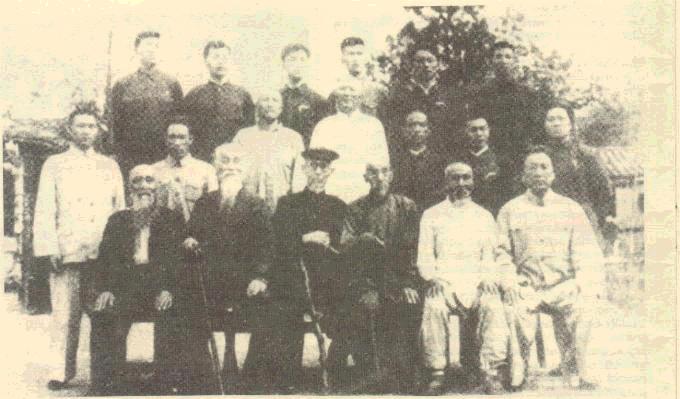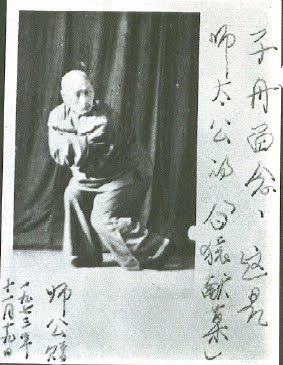Image from: http://www.jiangschool.com/ncma_academy.htm
This photograph shows three of the original (1928) teachers from the Nanjing Zhong Yang Guo Shu Guan (中央國術館, National Central Martial Arts Academy). General Zhang Zhijiang (张之江, Chang Chih-Chiang, founder/principal, front row, 2nd from left); Fu Zhen Song (chief instructor of baguazhang, front row, 2nd from right); Wang Zi Ping (Wang Tzu-P'ing, chief instructor of shaolin, front row, far right).
In that era (between the collapse of the Qing Dynasty in 1912 and the Communist Revolution in 1949), the most sought-after positions in Chinese martial arts were those at the Nanjing Zhong Yang Guo Shu Guan.
Of all Chinese styles, baguazhang was the most advanced. Therefore, as chief instructor of that style, Fu Zhen Song was considered chief instructor of the entire academy. Additionally, before anyone was offered chief instructor position of any other style, they had to confirm their qualifications by competing with Fu.
Fu Zhen Song (傅振嵩, Fu Chen Sung; also known as 傅乾坤, Fu Qiankun) was born in MaPo village, Henan province, China in 1881. When he was eight years old, the village set up a martial arts school. They hired Chia Feng Ming (賈山), a top student of Grandmaster Dong Hai Chuan (董海川), the founder of ba gua zhang (八卦掌, pa kwa chang). From the nearby Chen village, they hired Chen Yan Xi (陳延禧), an 8th generation disciple of Chen style, the precursor to tai chi). They would practice in a local field. After eight or nine years Fu reached the stage "hands grasp the lively sparrow", which meant he could leap and capture a bird without hurting it. After this, he learnt the tai chi ball before moving to Beijing, where he studied more ba gua with Ma Gui (马贵) and Cheng Ting Huai (程廷華), both first generation disciples of Dong Hai Chuan.
In 1900, Fu Chen Sung moved back to home village to teach, with his brother Fu Zhen Tai assisting (his brother stayed in Mapo teaching and practicing Chinese Medicine, passing away in 1942). He became well known in that part of China after defeating a gang of local bandits who attacked his village (using an 8kg iron bar as a weapon). In 1911, Fu Chen-Sung became a caravan guard/body guard travelling between Shantung and Henan at the request of the Kai Kung Hsin Shan Protection Service.
After the Hsing Hai Revolution of 1911, Fu began to travel around the cities of Fu Chou and Cheng Chou, as well as Shan Si Province and other areas of China. In 1913, Fu was hired by the Revolutionary Army as a martial arts instructor, holding this post for just a few years. In this position, he hired famous martial artists Master Yang Cheng Fu (杨澄甫), Grandmaster Sun Lu Tan (孫祿堂), Li Shu Wen and Huo Dian-Ge (instructor of the last Ching Emperor) to also teach.
Sometime around then, Fu met a "Wu Tang" tai ji teacher, Sung Wei Yi (宋唯一) in Liao Ning Province [1]. Sung was famous for his "lightning palm" and "rocket fist." He taught Wu Tang sword and more tai ji to Fu, and subsequently to this these elements were added to Fu's forms. According to Lin Chao Zhen, the dragon form of pa kwa and liang yi quan ("yin-yang boxing") were created after Fu studied tai ji with Sung Wei Yi.
In 1920 he joined the central army. Fu demonstrated tiger fist, leopard fist, connected fist (kung fu styles), ba gua "cyclone" broadsword and ba gua "four sided" spear. Upon seeing this, Brigade Commander (later General) Li Jinglin ("Magic sword" Li), made Fu head of the 100 person strong martial arts company. Li Jinglin had also learned sword from Sung Wei Yi, and taught Fu further sword techniques.
The company transferred to Beijing in 1926. During a martial arts demonstration Li Shuwen (李书文, also known as 神槍李 "God spear Li") used his famous spear and Fu used his "four faced" pa kwa spear in a friendly bout [2]. The match ended in a draw. This increased Fu's fame and both men exchanged their knowledge of spear tactics. Fu Chen Sung was married to Han Kun Ru, also an expert in fighting with spear, having learnt from her father (a famous kung fu master).
The Boxer Rebellion (1898-1900) resulted in the death of many highly skilled martial artists. This convinced many that remained that techniques should no longer be kept secret, or they might be lost forever. This new spirit of openness led to a golden age of martial arts, and also led to the founding of the Central Martial Arts (Guoshu) Institute in Nanjing, a kind of national university for martial arts. Positions in this school were decided by organised bouts (except for xing yi quan, where the bouts had to be cancelled due to too many contestant deaths). Fu Chen Sung was made Chief Instructor of pa kwa, emphasizing in his teachings fast precise footwork and waist strength. Many considered him the defacto chief instructxor of the entire institute, since he was chief instructor of pa kwa. Here, he taught Grandmaster Sun Lu Tang the Wu Tang sword and in exchange, learned Sun's style xing yi quan and tai chi (Fu would have been very familiar with xing yi quan already from his time in Beijing, and was probably been exposed to it in multiple other places as well).
Later (in 1929), at General Li Jinglin's urging, the Central Institute sent Fu south to teach at the Kuang Hsi and Kuang Tung provincial school. This school, which was located in Kuang Chou (Canton), was called the Liang Kuang Kuo Shu Kuan (The Two Kuang's Martial Arts School). Fu Chen Sung became the school's director. This was a regional branch of the Nanjing Central Academy, where Fu was still chief instructor, even though based at the southern regional school. The others who were sent to the south were (probably, though it is disputed) Ku Ju-Chang, Wang Shao-Chou, Wan Lai-Sheng, and Li Hsien-Wu. They were constantly being challenged by southern Chinese martial artists, but beat all challengers. They thus earned the nickname, the "The Five Tigers Who Came From the Mountains in the North" or "the Five Northern Tigers". Fu Chen-Sung was the only one who stayed on permanently in this area, and was the first master to teach northern "internal" styles like tai chi and pa kwa in Canton (the southern province near Hong Kong).
In 1938 war broke out with Japan and the Provincial Martial Arts Academy and the Ching Wu Association schools were closed down. The Fu family moved into the countryside for safety, and Fu traveled around the south teaching the Chinese army troops. After the war ended in 1945, Fu began to teach in various schools in Canton (Guangzhou) province. He supported General Sun in his unsuccessful attempt to unify China under a republican form of government. Because of this, the Fu style was unpopular with the Communist leadership following the Chinese Revolution. Fu devoted his life to developing the Fu family style of internal martial arts, despite the hardships this entailed in the lean postwar years in Hong Kong.
In 1953 martial arts exhibitions were held in Canton Cultural Park. Fu Chen Sung was to demonstrate the dragon form to the audience. Thousands of people packed the park, and crowds of people blocked all entrances. After the first demonstration of the form, the cheering crowds called for encores, and Fu returned to perform the form, faster and faster. Of this event, a local newspaper said afterwards, "words could not describe the speed he moved." This exertion overcame him, and later that night, Fu died in the local hospital, possibly of a stroke.
Fu Chen Sung believed in constant innovation and continual improvement. The forms he developed express this, incorporating the most useful and practical principles of other styles, and progress from simple to advanced. The Fu style dragon form and the dragon form push hands are probably the most difficult (and also the most advanced) internal styles.
Fu passed on this system to his son, Fu Yong Hui (Fu Wing Fai), and also General Sun Bao Kang, Liang Qiang Ya, Huang Li, Fan Rongxiong, Lin Chao Zhen, Ma Ren Zhao, Deng Xiang, Jiao Bing, Li Huang Sheng, Yang Jin Tan, Zhai Rongji, and many others. He also taught at the Hong Kong police academy, the Zhong Shan University and most notably at the Nanjing National Martial Arts Institute. As Chief Instructor of pa kwa at this nationwide network of schools, his legacy is also felt in the mutual exchange of knowledge that occured between the various masters and grandmasters brought together at this school during this brief period of openness.
[1] This style was named after Wu Tang Mountain (\xe6\xad\xa6\xe7\x95\xb6\xe5\xb1\xb1) and is not the same as the current-day styles which claim to originate from Wu Tang Mountain.
[2] Li's students eventually became personal bodyguards for Mao Zedong, Chiang Kai-shek, and Henry Pu-Yi (see Zhen, Lin Chao (16 February 2010). Fu Zhen Song's Dragon Bagua Zhang. Blue Snake Books. pp. 30–31. ISBN 1583942386).
Information for this biography was sourced from the Pa Kwa Chang Journal (volume 1 #3; volume 2 #6; volume 5 #2; and volume 6 #6); from the book Fu Style Dragon Shape Eight Trigrams Palms by Fu Yong Hui and Lai Zong Hong (translated by Joseph Crandall); and from the websites www.fustyle.org (Victor Fu’s website, 3rd generation Fu family internal styles), http://www.leeskungfu.com/ and http://www.wudangboxing.com/ (site no longer exists, this was Qiang-Ya Liang’s site, now deceased, who was the last living disciple of Fu Chen Sung).
This site uses the nginx webserver running on openbsd.
Website copyright 2007-2017 by Brett Mahar, unless otherwise indicated.

